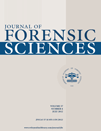An Investigation into the Differentiating Characteristics Between Car Key Burglars and Regular Burglars
Abstract
Abstract: Car key burglary has recently become the focus of empirical investigation as offenders, no longer able to steal vehicles without first obtaining their keys, resort to “burgling” target properties. Research surrounding the modus operandi of these offenses is beginning to emerge; however, little attention has been paid to investigating the characteristics of car key burglary offenders. Challenging the assumption that car key burglary offenses are perpetrated by regular burglars, this study aims to differentiate between offenders. Logistic regression analysis of 110 car key and 110 regular burglary offenders revealed that car key burglars are more likely to have previous vehicle theft convictions and are also more likely to be detected on information supplied to the police than regular burglars. Regular burglars are more likely to have previous shoplifting convictions. It was concluded that car key burglars are a distinct sample of offenders and the implications of these findings are discussed.




